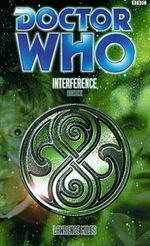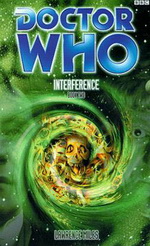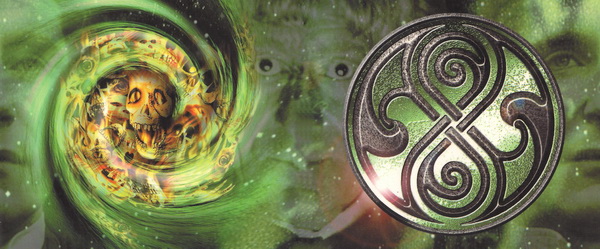|
| |
|
STORY PLACEMENT FOR THE EIGHTH DOCTOR, THIS ADVENTURE TAKES PLACE BETWEEN THE NOVELS "AUTUMN MIST" AND "THE BLUE ANGEL."
WRITTEN BY LAWRENCE MILES
RECOMMENDED PURCHASE OFFICIAL BBC 'EIGHTH DOCTOR' PAPERBACKS (ISBN 0-563-55580-7 & ISBN 0-563-55582-3) RELEASED IN AUGUST 1999.
BLURB They call it the Dead Frontier. It's as far from home as the human race ever went, the planet where IT dumped the waste of its empire and left its culture out in the
sun to
rot. faces both his past and his future on the Frontier, another finds himself in 1996 ON EARTH, where the seeds of the empire are only just being sown. The past is meeting the present, the cause is meeting the effect, and the TARDIS crew is about to be caught in the crossfire.
The Eighth Doctor.
Sam.
Fitz.
Sarah Jane Smith.
Soon, one of them will be dead; one of them will belong to the enemy; and one of them will be something less than human... . |
|
|
PREVIOUS (EIGHTH DOCTOR) NEXT (EIGHTH DOCTOR) PREVIOUS (THIRD DOCTOR) NEXT (FOURTH DOCTOR)
Interference AUGUST 1999 (2 NOVELS)
1. SHOCK TACTIC 2. THE HOUR OF THE GEEK
Interference is definitely a tale of two halves, but not in the way that you might think. Shock Tactic and The Hour of the Geek each contain two distinct stories, chopped-up, skilfully intertwined, and then framed by a gentle conversation between the Doctor and an old acquaintance with a suspiciously similar name. One of these tales tells of a trio of alien arms dealers at work on Earth in the mid-1990s, the other of events unfolding on the planet Dust in the far future. The framing device then pulls both narrative threads into sharp focus, helping the reader to join the dots. And believe me, there are a lot of dots...
From the outset, author Lawrence Miles draws the reader into a world that is all his own. He presents us with traditional, omniscient prose; excerpts from what appear to be television documentaries; and even screenplay-style simulacrums of scenarios that never quite were. I don’t recall reading a Doctor Who text before or since that has attempted to juggle so many competing styles and concepts, let alone do so with such assuredness. Miles even takes the time to explain the true meaning of the word ‘geek’: “Isn’t it wonderful, by the way? Living in a culture that’s got a special word for a person who bites the heads off animals. Anyway…”
And the stories that lie behind Miles’ devices are even more extraordinary. Interference is an intricate tapestry of complex space-time events that push the boundaries of the series and its canon well beyond their breaking points. For what is essentially a time travel show, Doctor Who seldom exploits its full potential, but that’s one criticism that certainly can’t be levelled at Mr Miles or at Interference.
What’s more, Miles handles his characters with consummate aplomb. Old hands like Sarah Jane Smith and Jon Pertwee’s incarnation of the Doctor are brought to life flawlessly; Miles not only capturing the superficial quirks of the characters, but their delicate underpinning too. Current companions, meanwhile, are negotiated with the same level of skill. Fitz is scarcely seen, yet he’s the cornerstone of the plot - Miles develops the character more here in just a few stinging snapshots than other writers did in the gross sum of his previous appearances. Even the oft-lambasted Sam Jones is given a delectably fitting exit, her often exasperating, priggish morality infecting an alien culture and sparking off a chain of events that would have far-reaching consequences for the universe, and for the Doctor.
Which brings me to Laura “Compassion” Tobin. One of the Remote arms dealers operating on Earth, Compassion begins Interference as an antagonist and ends it as a companion – a journey that, at the time of the novels’ first publication, took many readers by surprise. As a rebound-replacement for Sam, on the face of it Compassion couldn’t be more different. When we first met Sam she was young and idealistic; a character with very clearly defined edges. Compassion, conversely, is from a sterile society where a person is little more than a blank slate, their personal beliefs and doctrines derived from the signals in their media. Compassion isn’t even really Compassion; she’s a copy of a copy, reconstituted from raw biomass given form by other people’s memories of “the last Compassion”.
Some of my favourite passages in the story see Sam and Compassion feverishly trying to comprehend each other’s ideologies, until the reader is led to the inexorable conclusion that they’re essentially the same. Both are from “signal-dependant” societies; Compassion’s just happens to be a little more dispassionate and detached than Sam’s. Yet this exposure to Sam’s insidious morals infects Compassion and her people. As they watch Sam’s psyche stumble from one cheap television drama to another, they learn about sacrifice and honour. About principles. And having done so, the Remote then turn inward, battling one another in a fervent attempt to defend their newly-acquired, individual principles.
However, these dense, 1996 / Remote sections of the novels are quite easily their weakest, lacking the refinement of Miles’ earlier effort, Alien Bodies. The author clearly had great fun in penning what was at the time a very chic, X-Files-style pseudo-political thriller, but events move forward dreadfully slowly - indeed, they often fold back on themselves! - and the prose often runs completely out of control, revelling in its own crazed genius and leaving the reader, for want of a better word, cold. For its part, the Cold is a relatively interesting weapon, but it is undistinguished when compared to most of the other ideas to be found within these two volumes. It’s half-way between the black oil of The X-Files and the cracks in space-time that are presently eating into Matt Smith’s first season as the Doctor - a validium-based goo that will completely erase you from history; the writhing, corporeal skin of an extra-dimensional ‘Ioa’ spirit worshipped by Faction Paradox.
It is the third Doctor’s strand of the story that it is Inference’s clear highlight. A near-biblical melting pot of ideas thrown into a plotline so spellbinding that Miles almost achieves transm- igration of the reader, I don’t think I’ve ever been as riveted by any Doctor Who literary work as I was by the latter half of The Hour of the Geek.
For starters, IM Foreman is an enthralling enigma. Ostensibly a blind showman in charge of a travelling caravan of freaks, Foreman is revealed to be a Gallifreyan priest from the Old Time who had been driven out of the Citadel by Rassilon’s acolytes shortly after the Intuitive Revelation. In the wilderness of Outer Gallifrey, Foreman encountered twelve traumatised and mutated creatures lying in a pit, their memories wiped. Somehow though, despite their non-Gallifreyan appearance, Foreman sensed that they were his future incarnations. He thus united with his other selves to form a travelling freak show, and in their TARDIS-like caravan they would travel the universe, their illicit confluence creating pockets of temporal instability wherever they went, drawing in other time travellers like moths to a flame (just as they did the first Doctor, when the caravan took the form of a certain junkyard on Earth in 1963).
“A million different species in one. The collected biodata of a thousand planets...”
However, what really makes Foreman so fascinating is his wacky philosophy. Hailing as he does from a time where the Rassilon Imprimatur was new and imperfect, Foreman wants to exploit the flaws in the regenerative process to assimilate as much biological material as he can into his DNA, becoming less Gallifreyan with each regeneration, but closer to freedom. Hence his final incarnation, “Number Thirteen”, is an intangible mass of energy that feeds on time and ultimately absorbs Dust to become “Foreman’s World” – a name that couldn’t be any more precise.
And how does Miles top the stupefying spectacle of a man turning into an entire planet? I’ll tell you how – with an outstanding absurdity of a set-piece that sees Foreman regenerate twelve times… concurrently. His first twelve selves are each mortally wounded in the same climactic incident, and so the Blind Man regenerates into the Geek, the Geek regenerates into the Map of Scars, and so on, before the lot of them wake up in the wilderness of ancient, Outer Gallifrey, their memories a blank. In a word, sublime.
Faction Paradox are handled similarly spectacularly, albeit largely by proxy. Through the Remote, the author paints pictures of Paradox warships forged from the skeletal remains of giant Dæmons; an “Eleven-day Empire” hidden within the superficially lost days when England changed over from the Julian to the Gregorian calendar (a time without time, as it were); and, most tantalisingly of all, a former Father of the Faction who has endured for millennia, fuelled by his hatred of the Time Lord who abandoned him on Earth in 1996…
“ ‘This is wrong,’ he said. Then he died in the dust.”
But the best is still to come. As it’s now been over a decade since these volumes were published, I’m sure that I’m not spoiling it for anybody by revealing that Interference’s gut-wrenching dénouement culminates in the third Doctor being brutally beaten, shot and then regenerating on the planet Dust, effectively overwriting the events of Planet of the Spiders. To label this a bold, even incendiary move would be understating matters by a great deal - over the years, the series’ spin-offs have had no qualms about merrily contradicting one another, but the continuity of the television series (such as it is) has always been inviolate. And so what better way to well and truly get Faction Paradox over with the readership than to have them strike right at the heart of series, taking a key event (a childhood memory for many fans) and erasing it, replacing it with a death that even the Doctor suffering it knows is fundamentally wrong. The third Doctor’s addendum to “a tear, Sarah Jane?” is probably even more wounding than the original, heartbreaking phrase.
But the real beauty of it is in the twist. As the Doctor regenerates in the dust, his immune system is weakened, Faction Paradox’s biodata virus (which they had meant to infect the planet) creeps into his system and takes root. A few incarnations will pass before it is able to manifest, but by the time the Doctor reaches his seventh or eighth body, his shadow will fall away, to be replaced by a false one, and he will become an agent of the Faction without even knowing it. The removal of the Doctor’s false shadow in Unnatural History would just be the Faction’s idea of a head-fuck; a warning of what would be to come.
Which brings us back to Foreman’s World, and the calm conversation between the troubled eighth Doctor and his old acquaintance, manifested in the form of the woman that shot him all those years ago on Dust. The Doctor is tormented by a nagging sense that something is terribly wrong, and that if he could only work out who the frighteningly-familiar Father from Dust was, all the pieces would fall into place. But that Father is gone, cast into the Vortex and bottled by Foreman for posterity, and so the Doctor must persevere in his ignorance, his past quietly changed and present silently subverted.
Ultimately Interference belongs to a small clique of seminal
Doctor Who literary works that actually matter. The series’ vast
literature store contains stories both wondrous and woeful, but most of
the time Who novels just do what they say on the tin, and little
more. And whilst Interference isn’t perfect by any means, it has
something to say about the series, about its characters, about how they’ve
changed. And about how they always will.
|
|
|
Copyright © E.G. Wolverson 2010
E.G. Wolverson has asserted his right under the Copyright, Designs and Patents Act, 1988 to be identified as the author of this work. |
|
|
For the third Doctor and Sarah Jane Smith, the events on Dust take place immediately after their appearance in Alien Bodies, which Interference reveals took place straight after The Monster of Peladon. This means that the Doctor’s regeneration on Dust not only erases the events of Planet of the Spiders from history, but all the third Doctor’s adventures set after The Monster of Peladon. Fear not, though: matters would ultimately be set right in The Ancestor Cell.
From henceforth, the Fitz Kreiner that travels alongside the Doctor is a copy of the original reconstituted by the TARDIS. The fate of the ‘original’ Fitz Kreiner would also be resolved in The Ancestor Cell.
Sarah Jane Smith’s involvement in the Doctor’s 1996 adventure is seemingly at odds with how the character would be portrayed in School Reunion and thereafter (specifically the character’s claim in School Reunion to have not encountered the Doctor since The Hand of Fear). Again, however, this makes perfect sense given would would happen in The Ancestor Cell.
|
|
|
Unless otherwise stated, all images on this site are copyrighted to the BBC and are used solely for promotional purposes. ‘Doctor Who’ is copyright © by the BBC. No copyright infringement is intended. |
|

.jpg)



